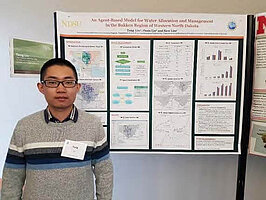Water Resources Impacts and Management in the Bakken Region of Western North Dakota

Tong Lin is a PhD student in the Environmental Science and Conservation Program at North Dakota University (NDSU). He holds a B.S. degree in Geographic Information System from Anhui Normal University, China. Tong Lin is currently working on an NSF funded project titled “A Model for Groundwater Allocation and Management at the Bakken Shale in Western North Dakota”. His research is focused on assessing fresh water use for hydraulic fracturing at Bakken and their current and future impacts on regional water resources.
Water Resources Impacts and Management in the Bakken Region of Western North Dakota
Research Abstract
Unconventional oil production at the Bakken Shale of western North Dakota has greatly increased nearly ten-fold from 2008 to 2014. During this period, Bakken Shale drilled approximately 10,000 horizontal wells and their hydraulic fracturing (HF) water demands increased around 20 times. A water depot-based water allocation system has emerged to distribute these tremendous HF water demand, and the system was well simulated by an agent-based model we developed and calibrated. Despite being in a semiarid region, the impact of Bakken development on regional water supply was limited because the water in the Bakken was adaptively managed and the region received on average over 20% more precipitation than normal during 2008-2014. However, if the precipitation remains normal or dries up, the increasing HF water demands could be stressful to regional surface water resources. To address future potential HF water stress on the regional water resources, we will develop a two-step project. First, we will integrate our agent-based model with SWAT model to study surface water impact from Shale oil development under normal or dry climates. In the second step, we will integrate an agent-based model with MODFLOW to study groundwater impact from hydraulic fracturing under different climate and management scenarios.
Research Highlights
To investigate the impact of the hydraulic fracturing (HF) water use on streamflow in the Bakken region of western North Dakota, we developed a SWAT model for simulating the hydrological processes of the Little Muddy River. The SWAT model was calibrated using the observed streamflows from 2004 to 2011 and validated from 2012 to 2014. The calibration and validation results showed that the SWAT model simulated the streamflows in the Little Muddy River fairly well. We then integrated the calibrated SWAT model and the agent-based model to predict streamflow changes under different precipitation conditions and HF water use scenarios. The simulation results indicated that the streamflow in the Little Muddy River was not much influenced by the HF water use at the Bakken. Instead, precipitation was a more influencing factor than the HF water demand in reducing the streamflows in the Little Muddy River. When the total HF water demands in the Bakken region increased 100 times, the streamflow in the Little Muddy River would decrease 4.7 ft3/s (approximately 6.1% of the annual average streamflow). We plan to further couple the agent-based model with the calibrated Fox Hills-Hell Creek MODFLOW model (provided by the ND State Water Commission) to study the impact of the HF water use on the Fox Hills-Hell Creek aquifer under different future scenarios.

Zhulu Lin
AES Ag & Biosystems Eng
Office: Ag & Bio Eng 104
Telephone: 701-231-7118
Email: zhulu.lin@ndsu.edu


